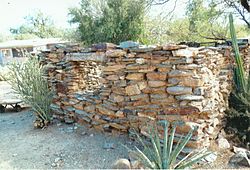Jacob Snively facts for kids
Quick facts for kids
Jacob Snively
|
|
|---|---|

Jacob Snively was buried by Jack Swilling an Arizona pioneer on his property in Black Canyon City. The Sniverly grave site is located where the rocks and small cactus are pictured.
|
|
| Born | 1809 |
| Died | 1871 (aged 62) |
| Burial place | Jack Swilling house property in Black Canyon City, Arizona Territory. |
| Nationality | American |
| Occupation | surveyor, civil engineer, soldier, military officer, ambassador, paymaster general, quartermaster, government official, prospector, mine owner, judge |
| Employer | Republic of Texas government, self-employed |
| Known for | Being a soldier and government official for the Republic of Texas and discovering gold and silver mines in California, Arizona, and New Mexico |
| Relatives | David Snively (twin brother) |
| Military career | |
| Allegiance | |
| Service/ |
Texian Army (1835–1836) |
| Rank | Captain (Texian Army) Colonel (Army of the Republic of Texas) |
| Unit | First Infantry Regiment, Company A, Texian Army |
| Commands held | First Infantry Regiment, Company B, Texian Army |
| Battles/wars | Texas Revolution |
Jacob Snively (1809–1871) was an important figure in early Texas and Arizona history. He was a surveyor and civil engineer. He also served as an officer in the Texian Army and the Army of the Republic of Texas. Later, he became a miner during the California Gold Rush and an Arizona pioneer, discovering gold and silver mines.
Contents
Early Life and Education
Jacob Snively was born in 1809 in Greencastle, Pennsylvania. He had a twin brother named David. His family soon moved to Hamilton County, Ohio. Jacob studied hard to become a surveyor and a civil engineer.
Service in Texas
Jacob Snively moved to Nacogdoches, Texas, which was then part of the Republic of Mexico, in April 1835. He worked as a surveyor, mapping out land for the Mexican government. He also received his own land in July 1835.
During the Texas Revolution, Snively joined the Texian Army. In March 1836, he became a first lieutenant. By August, he was promoted to captain. In January 1837, Sam Houston appointed him as an ambassador to the Shawnee Indians. His job was to find out if the tribe supported Texas or Mexico.
In May 1837, Snively was promoted to colonel. He became the paymaster general of the Army, managing payments for soldiers. For a short time, he even acted as the secretary of war. He left the army in September 1837.
After leaving the army, he served as a captain in the Texas Mounted Rangers from September to December 1838. In 1839, he returned as paymaster general. By 1843, he was the army's quartermaster, in charge of supplies, and an assistant inspector general.
The Snively Expedition
In January 1843, Snively suggested a plan to get back at Mexico. This was because Mexican forces had raided San Antonio in 1842. They had also mistreated Texan prisoners. Snively wanted to stop Mexican traders returning from Missouri on the Santa Fe Trail and take their goods.
On February 16, 1843, he received permission for his plan. However, he was told not to enter United States territory. He gathered about 170 men for his group, which was not officially part of the Texas army. They called themselves the Battalion of Invincibles.
On June 20, they fought and defeated 100 Mexican soldiers near the Arkansas River. However, on July 15, U.S. soldiers surrounded them. The U.S. soldiers disarmed Snively's group because they had entered U.S. territory. Many of Snively's men then left for Texas or Missouri.
Less than 70 men remained. They continued their mission and found the train of goods they were after. But it was guarded by a strong force of Mexican soldiers. Snively's weakened group could not attack, so they returned to Texas.
Discoveries in the West

In 1849, during the California Gold Rush, Snively left his business in Corpus Christi with his brother David. He traveled across northern Mexico and then sailed to the gold fields in California. He spent nine years looking for gold there.
In 1858, he moved to New Mexico Territory. There, he led a group that found gold in the Gila River, about twenty miles east of Fort Yuma. This discovery led to a gold rush and the quick growth of a town called Gila City.
Snively also helped discover silver and lead ore at the Castle Dome silver mine. This mine was in the Castle Dome Mountains north of Gila City. In 1863, he and Hermann V. Ehrenberg created the Castle Dome mining district.
That same year, after the first election in the new Arizona Territory, Governor John Noble Goodwin appointed Snively as a judge. From 1866, Snively's businesses did well with the success of the Castle Dome mine. He made and lost small fortunes in other ventures in New Mexico and Nevada.
Later Life and Death
On March 27, 1871, Snively left his home near what is now Phoenix. He was with a group prospecting for minerals near Wickenburg, Arizona. Their group was attacked by about 150 Apache warriors at the White Picacho.
Snively was badly wounded and left behind by his companions. His body was later found in a dry creek bed, or arroyo. It was badly decomposed, and parts had been eaten by animals. He was buried nearby.
Seven years later, his friend and fellow Arizona pioneer Jack Swilling and two friends found Snively's remains. They moved his body from its remote grave. He was reburied behind Swilling's house in what is now Black Canyon City. This location was near a Wells Fargo stagecoach stop and an ore mill.
Honors
Snively Holes, a watering place in Arizona east of Bill Williams Mountain, in Coconino County, Arizona, was named after Jacob Snively.

